“Injection molding helps the automotive sectors by manufacturing components for engines, automobiles, EVs, and ICEs. It facilitates an economical and efficient approach to design intricate features of automotive components.”
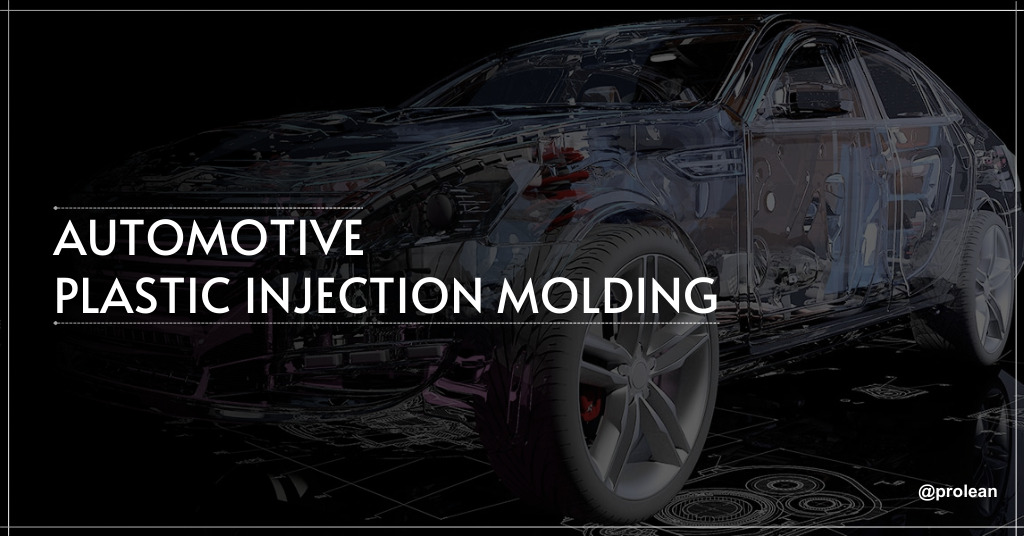
The traditional methods of automotive part production were laborious, expensive, unreliable, and time-consuming. Therefore, there emerged the need for advanced automotive plastic injection molding for fast, cost-efficient, and highly tolerant components which is where the current plastic injection molding came into existence. With the emergence of thermoplastics of various kinds, there exists an array of possibilities for producing recyclable, tolerant, and heat-resistant parts.
Keep on reading, because this article entails the thought details with technical reasoning of the automotive injection molding process, its applications, benefits, and prospects.
Injection Molding For Custom Automotive Parts
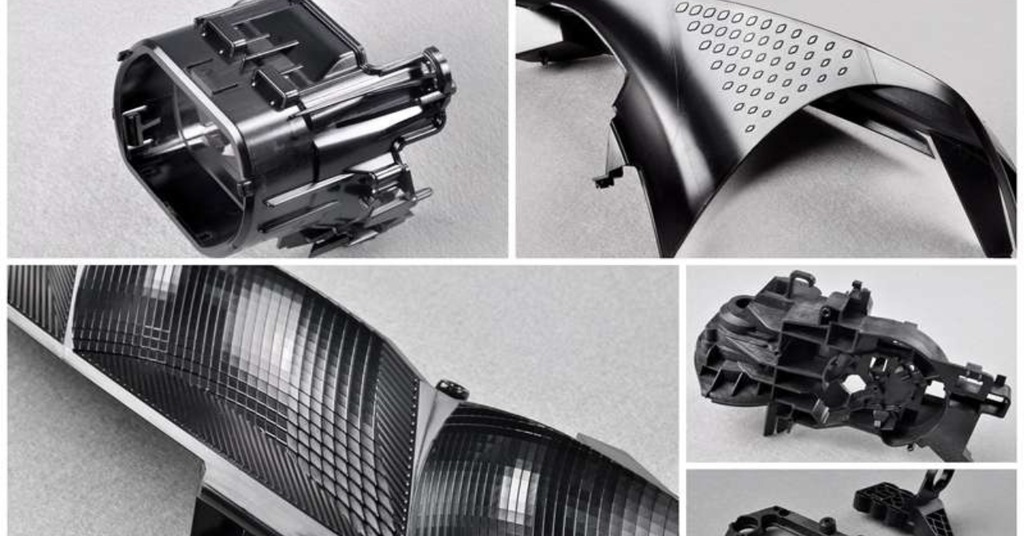
Custom injection molded automotive parts
In automotive injection, molding is a kind of fabrication process that uses high pressure to forge plastic for automotive parts. There are numerous applications of plastic injection molding in the automotive industry for providing a mass volume of components. Automotive injection molding allows engineers to manufacture top-quality plastic parts for electric vehicles, motorbikes, trucks, and cars.
To fulfill the current and future high-graded plastic parts requirement, there are multiple automotive injection molding companies globally. It is widely employed by original equipment manufacturers (OEM), and aftermarket auto part suppliers. However, the mold tooling is slightly costly in the injection molding process.
Related To: Custom Automotive Parts Manufacturing: A Complete Guide
Try Prolean Now!
Plastic Types Used in the Automotive Industry
The right choice of automotive plastic injection molded materials depends upon the application specifications. Automotive plastic parts are mission-critical and therefore should be manufactured from reliable, heat-resistant, corrosion-free, and durable plastics.
Additionally, certain industrial standards and regulations needed to be addressed to avoid customer complaints. The material choice is even more considerably critical when it comes to cost saving and energy expenditures. Here are some commonly used injection molding raw materials.
1. Polypropylene
It is predominantly used in the automobile industry because of its durability. The structural element of polypropylene is propylene polymer and it also comes with chemical resistance and high moldability. Due to these properties, it is suitable for automotive parts like cable insulations, car bumpers, engine covers, and gas cans.
2. Polyurethane
It is made up of plastic polymer urethane and it offers exceptional properties such as resistance towards extreme environments, and radiation and is chemically stable. It comes in multiple shapes from simple to complex depending upon the industrial need. These qualities make it an appropriate choice for the plastic fabrication of different components for instance suspension brushes, tires, headrests, and soundproofing.
3. Polyvinyl chloride
Polyvinyl chloride is an extraordinary heat tolerant, chemically resistant, and flexible plastic polymer. It approximately contributes 16% of all the plastics used in the current automotive industry. Fewer additional properties including brittleness, accessibility, durability, and low lead content benefit its application in fabricating components such as cables, dashboards, and vehicle airbags.
4. Acrylonitrile Butadiene Styrene (ABS)
It is a complex composite polymer of three monomers including styrene, butadiene, and acrylonitrile. ABS has a tough exterior and a shiny appearance alongside heat resistance and durability. Moreover, it is dyeable and has high conductive properties. Its multiple applications to be specific are in wheel covers, dashboards,s, and certain other automotive parts.
5. Polyamide Nylon 6/6
This plastic polymer has a sturdy nature, tolerance against heat extremes, and is wear-resistant. Nylon 6/6 is preferred due to its low cost, high tensile strength, and stability, for weatherproof coatings. It is a high-performance automotive thermoplastic used in gears, engine covers, fuel caps/lids, and door handles.
6. Polycarbonate
The impact resistance, rigidity, hardness, and transparency are the exceptional properties of polycarbonate. Moreover, this thermoplastic material is heat and wear-resistant making it an appropriate choice for manufacturing headlamp lenses, bumpers, and bullet-proof glass windows.
7. Polyethylene
Polyethylene offers low density, high durability, chemical stability, and high impact resistance to the manufactured parts. The weathering-resistant property against high moisture appropriates this material for windshield formation.
8. Polyoxymethylene
POM, also identified as Delrin, an acetal copolymer, refers to an automotive plastic. These materials have different compositions and specifications which provides design manufacturer’s multiple options while selecting fabrication techniques. Whether you employ CNC machining or Injection molding in automotive part manufacturing, POM stands as a resilient material to the machine through these techniques effectively.
What makes POM compatible with automotive component manufacturing? Let’s take a glance at assertive features that make it fit for the automotive industry.
- Its lightweight nature, high mechanical strength, stiffness, and similar properties to metals like steel, copper, and zinc make it an ideal option for manufacturing automotive components.
- Moreover, the rigid and sleek appearance of POM makes it efficient for improving the overall performance of auto parts.
- These materials can bear temperatures more than 100°C (212° F).
- Additionally, POM offers low gloss surfaces, design flexibilities, and durability when being used in automotive applications.
Common Grades of POM for Automotive Components Manufacturing
The following grades are useful for making seat belt adjusters, fuel supply units, vapor control valves, car locks, and gearing systems.
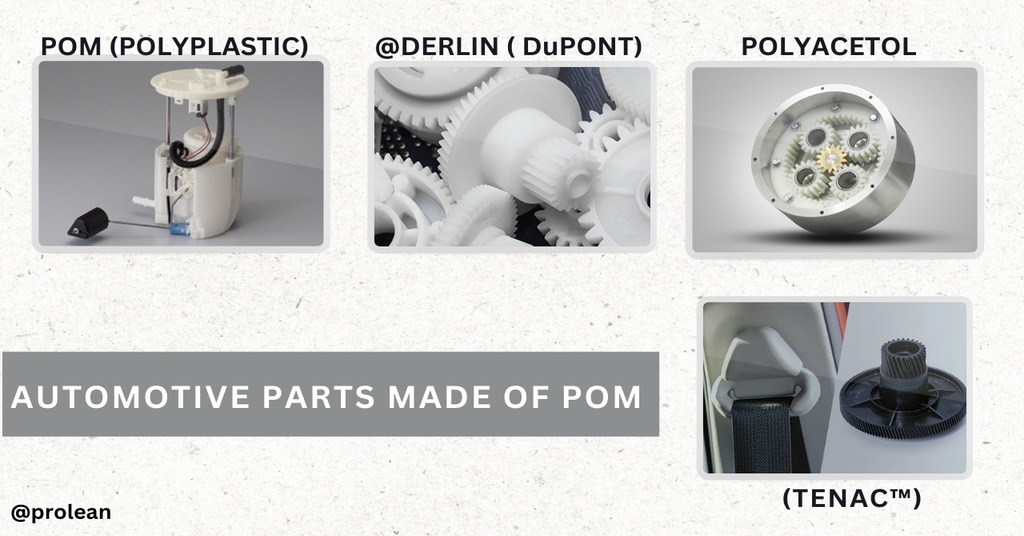
Automotive parts made of POM plastic
- Duracon Polyplastic Grades (DURACON® M90-45 LV, DURACON® NW-02 LV, DURACON® GH-25LV)
- Derlin Grade by duPont (DERLINl® 300TE)
- POM Copolymer (Tenac™-C Z4520)
Related To: Top Materials For Injection Molding
Injection Molding Types in the Automotive Industry
There are three types of injection molding types commonly used in the automotive industry for numerous component manufacturing. A short description of these types is given below.
1. Injection Molding Types in the Automotive Industry
Thermoplastic injection molding is most common and typically employed in the automotive industry. It uses polypropylene, nylon, and acrylonitrile butadiene styrene (ABS) to manufacture automobile parts. The benefits offered by this injection molding type over others are cost-effectiveness, versatility, and speedy production.
2. Elastomeric Injection Molding
The elastomeric materials specifically silicone and rubber, are used by the elastomeric injection molding technique to craft automotive parts. The numbers of merits offered by this type are rapid manufacturing, low cost, and adaptability. Besides these benefits, it also exhibits shock absorption properties and vibration dampening.
3. Thermosetting Injection Molding
It uses thermoset materials including glass fiber-reinforced materials, polyesters, and epoxy resins for part manufacturing. The correct dimensional tolerance and repeatability are the certain benefits of this type. The specific reason why thermosetting injection molding is popular is because of its resistance against deforming and melting. Moreover, these materials possess excellent load-bearing, shock-absorbing capabilities.
Click here to download: Custom Automotive Parts Manufacturing
Try Prolean Now!
Benefits of Automotive Injection Molding
Automotive injection molding supplier companies offer multiple services for product fabrication with certain benefits. The obtained components through this process are efficient and reliable. Some of the benefits offered by automotive injection molding are as follows.
1. Intricate Designs Precision
As mentioned earlier, the automotive industry prefers injection molding due to its highest precision level and accuracy. It comes in handy when it comes to complex design fabrication. By following the right molding approach and tooling design, it can produce a considerable quantity of plastic automobile parts. The molding chamber through which the molten plastic material passes and solidifies should be error-free to eliminate any possible risk of product deformation.
2. Durability
The thermoplastic used in injection molding is chemically stable and can endure environmental extremes. The resilience ability of these thermoplastics can increase the shelf life of the produced components to an extendable amount of time. On the other hand, the mixture of thermoplastics for creating hybrids and top-end blends can further signify the component quality.
3. Design Flexibility
Unlike traditional methods, injection molding permits the possibility of design modifications. The shapes and sizes of products can be easily modified and type-to-type designs are crafted by automotive companies. Moreover, the 3D printing technology along with CNC machining techniques has further enhanced modal practicability.
4. Fast production cycles
Injection molding can manufacture highly efficient components in a short amount of time. That is why plastic injection molding is renowned in the automotive industry for mass production. Quick molding cycles combined with precise complex part geometry are the key requirement of every manufacturer which can only be achieved by an injection molding technique.
5. Multiple material options with Better surface finish
A wide array of thermoplastic materials such as nylon, acrylonitrile butadiene styrene, polyethylene, polycarbonate, and rubber plastics are suitable for injection molding. These distinctive plastic polymers offer various accommodations to the product engineers.
Error-free and smooth surface parts manufactured from injection molding stand to customers. Engineers can use multiple finishing options like glossiness, matte, and roughness to the final product appearance.
6. Cost-effectiveness
The cost-effectiveness option of injection molding attracts businesses dealing with high production rates. Although the initial tooling cost of molding is somewhat higher it saves a lot of capital in large production runs. Higher repeatability is another option that enhances the cost-effectiveness of this process. So, by the use of this technique, automobile companies can easily cut the cost of production of highly sophisticated plastic parts.
Applicability of Plastic Injection Molding in the Automotive Industry
The advancement of plastic injection molding as a reliable, durable, and faster technology has created its irreplaceable place in every modern manufacturing industry dealing with plastic. The rising customer need for lightweight, chemically stable, and recyclable automotive parts is creating a paradigm shift.
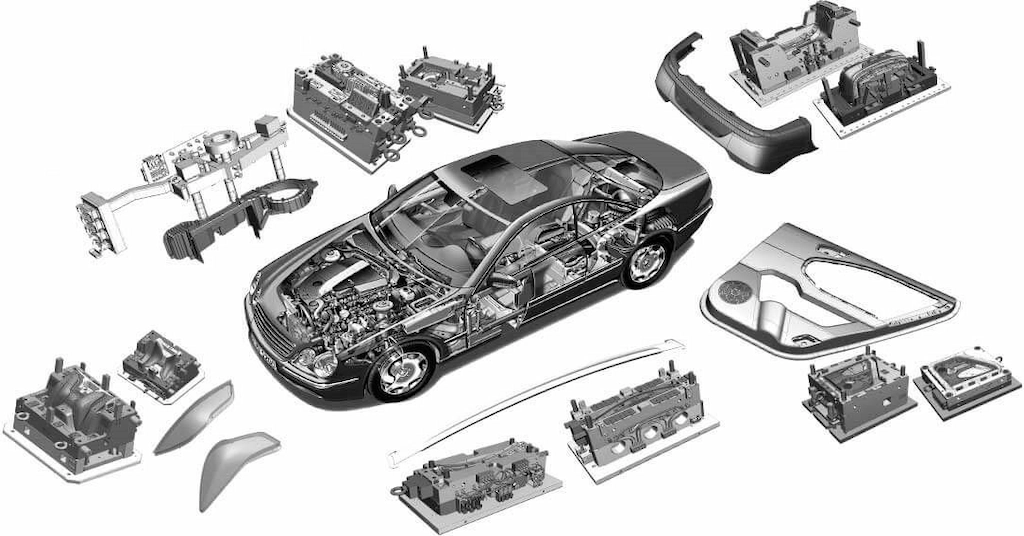
Benefits of automotive injection molding
The diversified use of plastic in automobiles including cars, vans, logistic vehicles, and motorbikes components production is on the rise. It is used in several automotive parts from the exterior e.g. headlight covers, bumpers, and fenders to the interior like battery casing, oil gauges, and cylinder heads.
Additionally, the components under the hood were traditionally made from steel, which nowadays, is composed of inclusive polymers ABS, PTS, and nylon. This component includes crankshaft, engine tubes and hoses, cooling shutters, and air intake manifolds.
Stand By to Avail Automotive Plastic Injection Molding at Pro-Lean
Prolean provides excellent and affordable services when it comes to automobile part manufacturing. We have a state-of-the-art manufacturing facility geared by experienced designers accommodating your prototyping and on-demand automotive plastic part manufacturing needs.
We possess a broad spectrum of professional-grade raw materials to choose from with the subject to maintain and increase tolerance, durability, and chemical and physical stability of fabricated plastic auto parts. With further due contact us for your customized auto mold manufacturing needs.
Read more:
- Foam Injection Molding: Types, Process, and Applications
- Top 9 Materials For Injection Molding
- How much does injection molding cost?
Try Prolean Now!
Summing Up
Injection molding is a viable solution for the fabrication of premium-quality automotive parts composed of plastic polymers. The consistency, safety, strength, and lightweightness of the molded parts are the key requirements of the automotive industry. It offers multiple benefits for example durability, short and fast production cycles, and economically reliable and uncompromised quality products by accommodating variable materials in satisfying customer’s needs.
After initial investment in molding tools, the manufacturer gets benefits in large production runs. Therefore, given modern industry, the importance of plastic injection molding can’t be ignored.
FAQ’s
Q1. Enlist the best molding process for making automotive plastic parts.
Well, after careful analysis of molding processes, plastic injection molding seems like the best option. Because it offers resilience, versatility, and cost-effectiveness in part manufacturing for the automotive industry.
Q2. Which country is at the forefront of automotive plastic injection molding technology?
In recent years, China has gained the reputation of being at the top of the world in providing high-quality automotive injection molding solutions across the globe.
Q3. Name the appropriate material for injection molding automotive parts.
Depending upon the product specification and application necessity, there exist several thermoplastics. To name a few regularly used polymers, Polyurethane, Polypropylene, and Polyvinyl chloride.
Q4. Are automotive injection molding and Automotive die casting similar?
Not, both of these processes are different on the scale of material used. Automotive injection molding uses pre-heated plastic polymers, on the other hand, molten metal is injected into the mold for component manufacturing. However, in both processes, the injected molten material solidifies and results in the desired component.
Q5. Any alternative to Injection molding for custom automotive parts manufacturing?
Yes, there are various alternative techniques to injection molding; including; CNC machining, 3D printing, casting, and metal extrusion.
Q6. Which types of molds are best for injection molding operations?
Most designers prefer aluminum injection molds for efficient manufacturing. Aluminum is an irreplaceable alloy employed for various industry use applications due to its mechanical strength.
Resource
D.F. Heaney (2012), Injection molding process: Handbook of Metal Injection Molding, Retrieved From Science Direct.

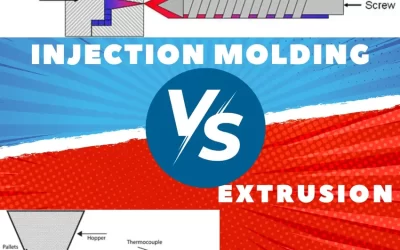
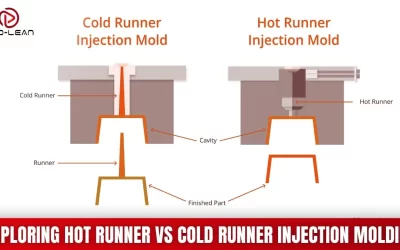
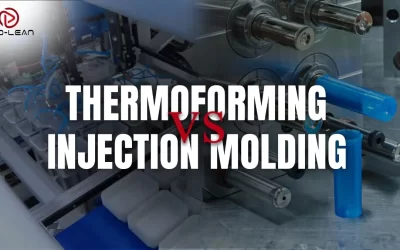
0 Comments